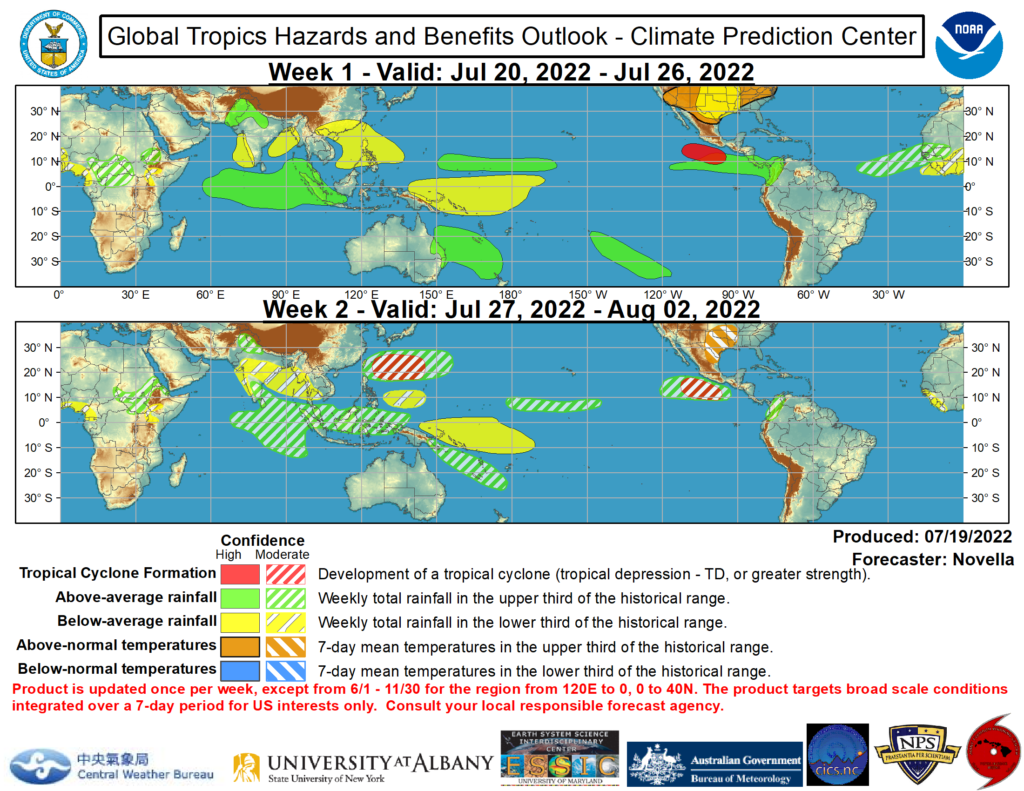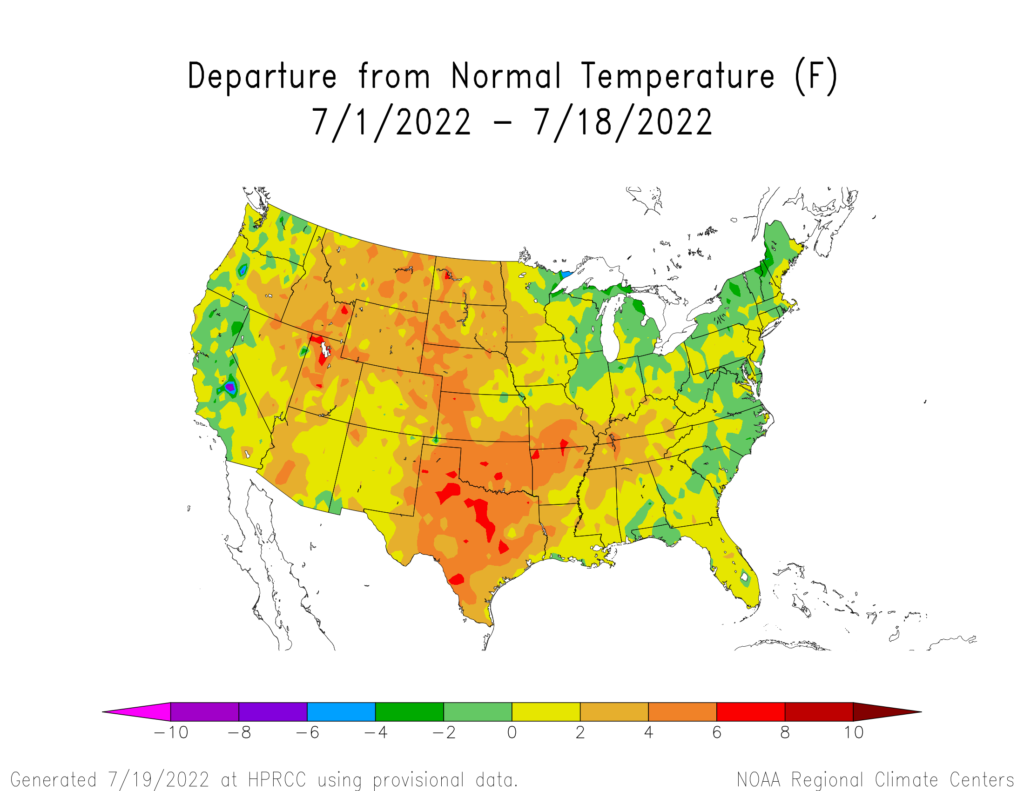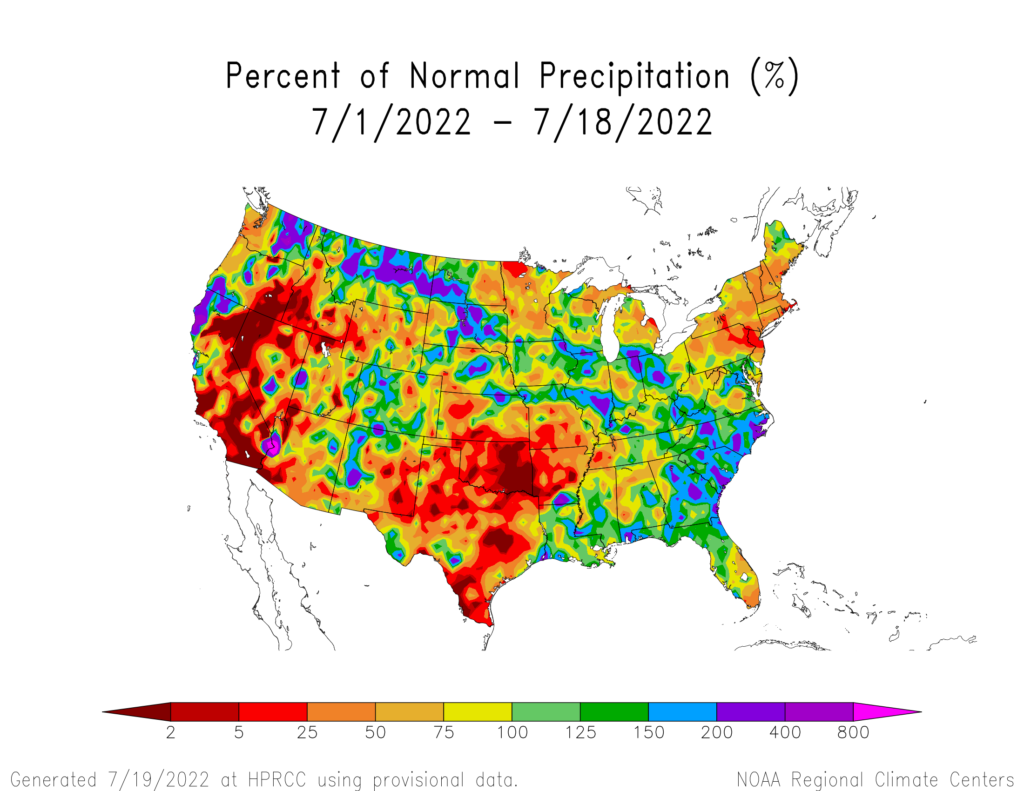Here is what we are paying attention to this evening and the next 48 hours from this evening’s NWS Forecast.
...Dangerous heat to continue impacting portions of the southwestern, south-central, and eastern U.S.... ...Severe thunderstorms possible across sections of the East Coast and the Southeast today... ...Monsoonal moisture to bring locally heavy rains and isolated flash flooding across portions of the Southwest into the southern Rockies...
Continuation of the NWS Short Range Forecast (It is updated twice a day and these updates can be found here.
The bulk of the country will continue to see above average temperatures through the end of the week, with a significant portion of the population remaining under heat-related advisories and warnings. These areas include the Southwest, where an Excessive Heat Warning for today and tomorrow extends from southeastern California and western Arizona northward into southern Nevada and southern Utah. Daytime temperatures are forecast to soar well above 100 degrees across much of the region both days -- topping 110 in many lower elevation locations, and some record highs are possible. Overnight lows are likely to remain in the 80s in many spots, providing little nighttime relief. From the southern Plains to the lower Mississippi and Tennessee Valleys, a weak front that has dropped in the region could continue to bring thunderstorms and some heat relief to parts of the region today compared to previous days with record-setting heat. However, it will remain quite warm and humid across the much of the region, and Heat Advisories continue to cover portions of eastern Oklahoma and Texas eastward, with some embedded Excessive Heat Warnings across parts of the lower Mississippi Valley and Deep South. Temperatures are expected to remain above average through the period, with daytime heat indices expected to climb well above 100 degrees across much of the region each day. Farther north, temperatures are forecast to heat up through the end of the week across northern and central parts of the Plains and Mississippi Valley, until a cold front brings some notably cooler temperatures into the northern Plains and the upper Midwest beginning Saturday. Finally, Heat Advisories along with localized Excessive Heat Warnings in eastern Virginia also stretch across parts of the East Coast with warm and humid air in place ahead of a cold front. Though the cold front is relatively weak in terms of temperature differences, it is helping support ongoing severe weather that could continue through this evening from the Carolinas northward across parts of the Mid-Atlantic and Northeast. Slight Risks of severe weather and Severe Thunderstorm Watches are in place from the Storm Prediction Center, and localized flash flooding is possible as well where rain rates are high. Severe weather and excessive rainfall are also threats over parts of the Southeast this evening as storms fire there and could move slowly. Monsoonal moisture is forecast to fuel daily showers and thunderstorms from eastern Arizona into the southern Rockies mainly during the afternoon and evening. While widespread heavy amounts are not expected, storms that develop may have the potential to produce locally heavy accumulations, with isolated flash flooding possible. Additionally, a couple of frontal boundaries and low pressure systems will help support scattered thunderstorms in the north-central U.S. over the next few days. Chances for severe weather will increase there by the weekend, and the Storm Prediction Center already indicates an Enhanced Risk over the Upper Midwest Saturday.
Maps that relate the forecast to geography can be found by clicking Here for Day 1 and Here for Day 2.
Here is a 60-hour animated forecast map that shows how the short-term forecast is expected to play out.
If it needs to be updated click here.
HAZARDS OUTLOOKS
Click here for the latest complete Day 3 -7 Hazards forecast which updates only on weekdays. Once a week probably Monday or Tuesday I will update the images. I provided the link for reads to get daily updates on weekdays. Use your own judgment to decide if you need to update these images.
Worldwide Tropical Forecast
(This graphic updates on Tuesdays) If it has not been updated, you can get the update by clicking here
Detailed Maps and Reports for the Western Atlantic and the Pacific Oceans
Below are three maps that summarize the situation for the Atlantic, Eastern and Central Pacific. Additional information can be accessed by clicking HERE
First the Atlantic
Click to view the forecast map and have access to additional information https://www.nhc.noaa.gov/gtwo.php?basin=atlc&fdays=5
Then Eastern Pacific
Click to view the forecast map and have access to additional information https://www.nhc.noaa.gov/gtwo.php?basin=epac&fdays=5
Then Central Pacific
Click to view the forecast map and have access to additional information https://www.nhc.noaa.gov/gtwo.php?basin=cpac&fdays=5
And the Western Pacific
Click to view the forecast map and have access to additional information https://www.metoc.navy.mil/jtwc/jtwc.html
Some Intermediate-Term Outlooks
Links to “Outlook” maps and discussions for three time periods. Days 6 – 10, Days 8 – 14, and Weeks 3 and 4. An outlook differs from a forecast based on how NOAA uses these terms in that an “outlook” presents information from deviation from normal and the likelihood of these deviations.
You have to click on the links because they do not update automatically and I do not want to have stale images in the article. But it is not difficult to click on a link and you get a large image plus a discussion. On Fridays in a separate article, we will show the images and provide a link in this article that article. But remember what you will see is the images as of Friday. But here you can get the current images simply by clicking on them. Then hit the return arrow at the upper left of your screen to return to the article. You will not find this information easily anywhere else.
Right now you can find these maps here (We show them every Friday there but you can click above and find them).
Month to Date Information
(These images do not auto-update – I update them from time to time, but the links are there so just click on them)
Temperature
Precipitation
Month to date Temperature can be found at https://hprcc.unl.edu/products/maps/acis/MonthTDeptUS.png
Month to date Precipitation can be found at https://hprcc.unl.e du/products/maps/acis/MonthPNormUS.png







